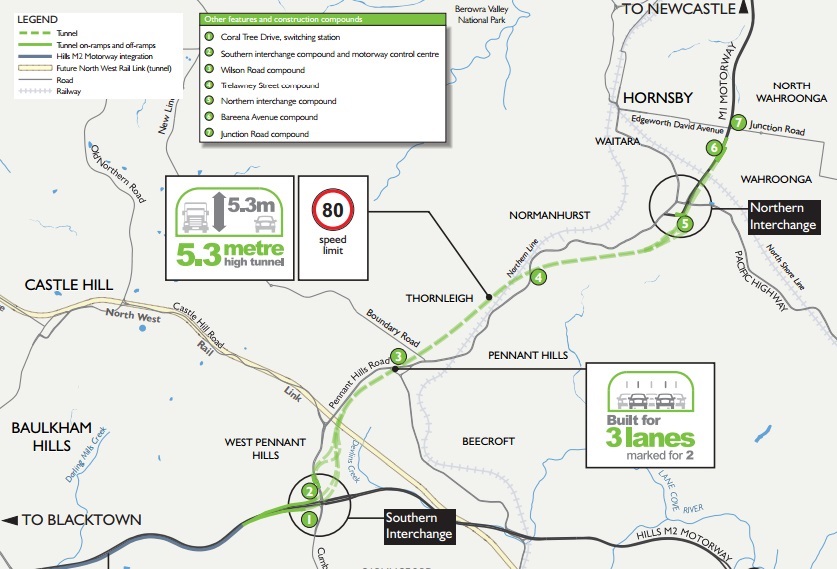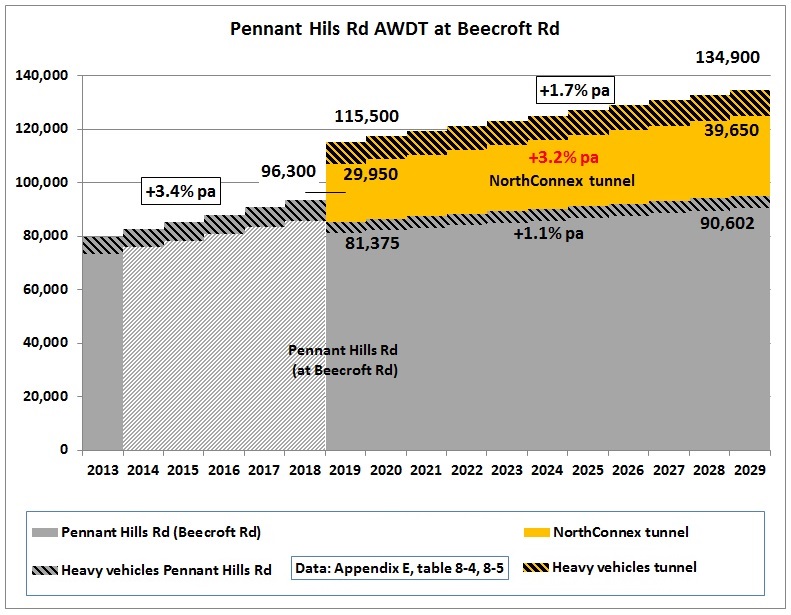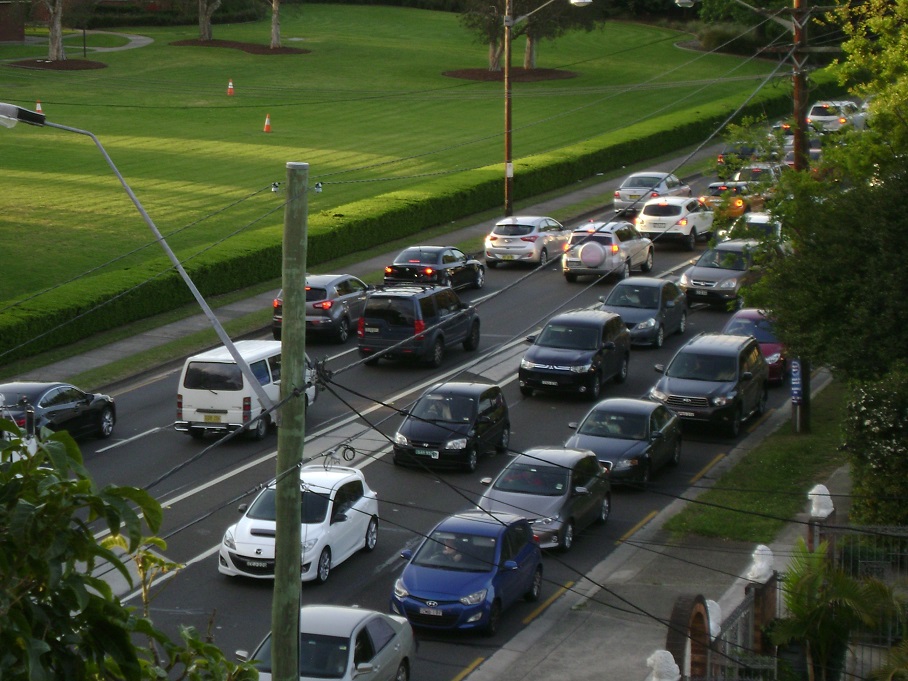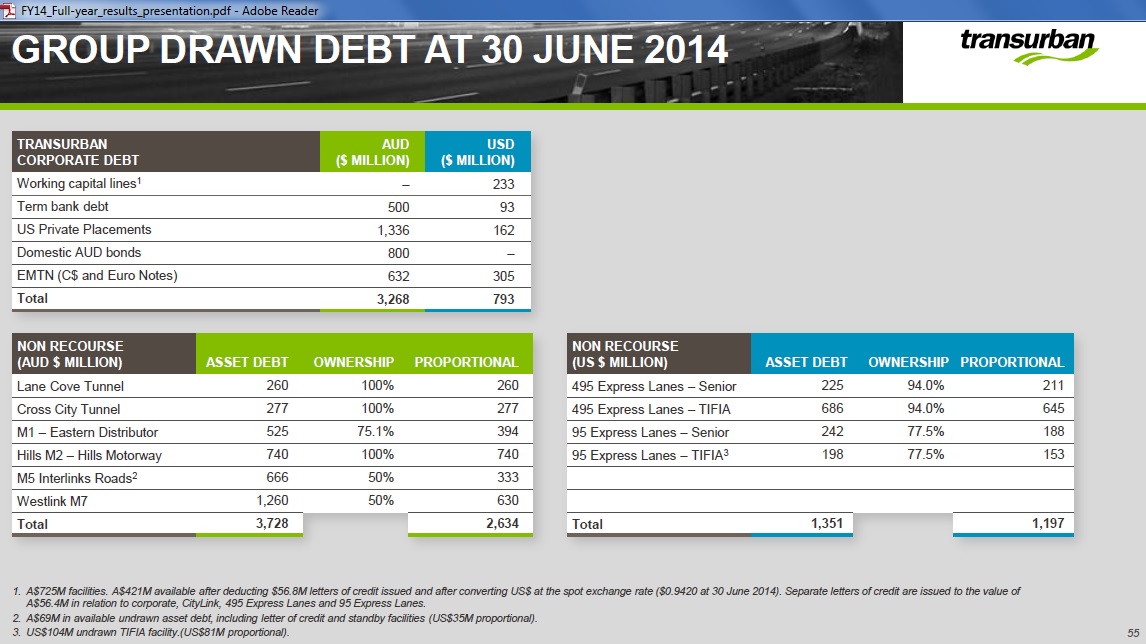Fig 1: NorthConnex tunnel proposal
http://northconnex.com.au/library.php
The current congestion problem on Pennant Hills Rd is caused by 4 distinctive traffic flows overlapping in this narrow corridor:
(a) trucks on the national highway,
(b) long-distance commuting from the Central Coast,
(c) inter-regional suburb traffic within Sydney and
(d) local traffic.
Fig 2: Pennant Hills Rd near Thornleigh station in March 2014
The proposed tunnel would only be a solution for (a) and parts of (b) with destinations in Western Sydney, would offer very little for (c) and nothing for (d). The current proposal would basically move most trucks into the tunnel thereby freeing up capacity on the road, which – however – is quickly filled by growing car traffic – under a BAU scenario, of course. For $3 bn this is not good enough. Even the EIS has recognised this in Vol 2, page 187:
“it does not fully resolve the congestion problems in the local area in the long term”
Fig 3: Traffic forecast as found in various tables of the EIS
The grey area represents surface traffic on Pennant Hills Rd, the yellow area traffic in the tunnel, the hatched areas heavy vehicles. The EIS should actually have provided such a graph or similar. There is an obvious lack of transparency here for the average reader of the EIS.
In 2019 there is a huge jump in traffic which is of course unrealistic. The EIS fails to calculate a transition period. Traffic on the Pennant Hills Rd drops in 2019 compared to the “without project” case but is higher than 2013 levels. Moreover, a continuous growth in tunnel traffic of 3.2% pa between 2019 and 2029 is above the normal GDP growth rate. Usually, a traffic forecast should calculate 3 different scenarios: low, reference and high (sensitivity analysis). Nothing of this sort was done.
A big problem would develop at the Southern end of the tunnel where traffic dumped on the continuing Pennant Hills Rd (Cumberland Highway, 2×2 lanes) would increase by almost 30%
Fig 4: Traffic jam on Cumberland highway, October 2014
All roads in the catchment of the proposed NorthConnex tunnel would need to be widened in order to accommodate the assumed traffic increase. In fact, only peak oil (high oil prices and/or physical oil shortages) will “solve” the current traffic problems.
Sustainable solutions will be imposed by external events anyway
From a strategic point of view each traffic stream requires its own sustainable solution: freight must go by rail (intermodal – video https://www.youtube.com/watch?v=9IxEPjwK34g),
Fig 5: Hupac intermodal train in Switzerland http://www.hupac.ch/
long distance commuters by carpooling and rail, and regional passenger traffic by buses and car pooling. This has to be done anyway as the easy oil is gone and the CO2 problem accumulates in the atmosphere and the oceans. We do not know whether oil shortages or abrupt climate change come first but these problems hang like a Damocles sword over Sydney. A road tunnel with a life span of decades would only unnecessarily delay this transformation process.
Debt increased and few taxes paid
The 3rd problem is finance and debt. The proponent of NorthConnex, Transurban, sits on A$ 8 bn of debt which they don’t attempt to pay back because the tolls are too low.
Fig 6: Transurban’s debt
http://www.transurban.com/files/FY14_Full-year_results_presentation.pdf
In this way, almost no tax is being paid.
Transurban pays just $3 million tax, despite collecting $1 billion in tolls
5/8/2014
http://www.smh.com.au/business/transurban-pays-just-3-million-tax-despite-collecting-1-billion-in-tolls-20140805-100le8.html
As shown in previous research on this website, 60% of the Federal deficit since 2008 is caused by a sharp drop in company tax. Finance is proposed to come from a government contribution, new debt and shares. So debt is increased and the government does not get any return from their “investment”. It is incomprehensible that governments want to subsidise such a company. It is totally against their own objectives and requirements. Moreover, Transurban’s debt situation means that this company is highly vulnerable in the next credit crunch which is only a matter of time. The Lane Cove tunnel went into receivership when debt could not be rolled over.
Oil crisis likely before 2020
Without US shale oil, the world would be in a deep oil crisis now and the question of a road tunnel would not have arisen. The International Energy Agency recently published a report which implies that the 2nd – and last- US peak will start in 2016. At the same time, the Russian Finance Ministry has warned that oil production will start to decline also in 2016. 3rdly, a religious war has started on top of Middle East oil fields. It would be naïve to think that this will not impact on oil exports from the region.
Peak oil mentioned but not as input into traffic model
Peak oil is mentioned in chapter 8.3 which is a strange mixture of issues on resources and waste. This alone reveals the mindset of the authors of this chapter. It is an afterthought inserted somewhere in the document WITHOUT any meaningful connection or as an input into the traffic chapter, for example. Excerpts from p 1022:
Peak oil
“Roads and Maritime are taking the view that it is prudent to consider that oil production may peak and then decline. This could increase the cost and reduce the availability of transport fuels and construction materials derived from oil. For transport, the solutions to the problem of “peak oil” are similar to those for climate change.”
“Alternatives to fossil fuels need to be found and transport must become more energy efficient. There are moves to establish alternatives to oil as a fuel for transport and to improve energy efficiency. This would enable the economic benefits provided by road transport to continue to be delivered with a reduced need for fossil fuels. Similar action is being taken, through recycling and investigation of alternative materials, to reduce the need for construction products derived from fossil fuels.”
“Roads and Maritime is also participating with Austroads and industry in research and trials with the goal of developing more sustainable road construction materials and practices and reducing reliance on products derived from oil. As road transport is a significant and necessary element of the NSW economy, that also provides many social benefits, Roads and Maritime will continue to ensure that all potential impacts on this system, such as peak oil, are identified and action is taken to manage these risks.”
“With reference to the project, traffic modelling across the Sydney network indicated that the proposed project would result in increased travel speeds and shorter distance of the tunnel compared to the surface roads. This would result in an overall reduction in the quantity of fuel consumed by private and freight vehicles and a subsequent reduction in the quantity of emissions produced. As noted in Section 8.4 (Greenhouse gas and climate change), it is estimated that by 2027, savings in operational road use emissions would be greater than the estimated emissions generated during construction of the project. Furthermore, it is estimated that operational emission savings from road use of around 68,600 Mt CO2-e would be achieved by 2029 when compared against the ‘do nothing’ scenario.”
So the authors of the EIS think that “peak oil” (in quotes!) is really no problem as alternative fuels need to be found. This implies that alternatives will be found. No quantitative analysis on the sources of primary energy is offered, neither for Australia nor globally. It is assumed that the marginal fuel savings which have been used to calculate CO2 emissions are sufficient to get us through. Australia’s oil vulnerability in relation to the Middle East has been conveniently omitted as a risk factor. The whole project is completely disconnected from reality.
Recommendations
State and Federal governments should use their $800 bn to continue with the ETTT project either between Thornleigh and Hornsby or from Rhodes to West Ryde with an additional rail bridge over the Parramatta River. The supports have already been built long ago.
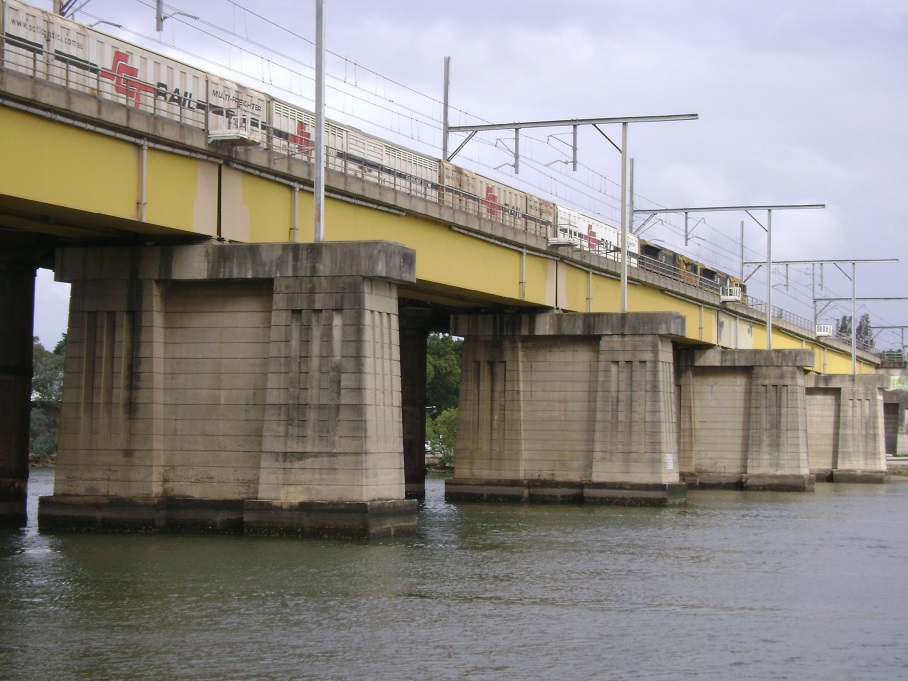 Fig 7: Missing tracks on rail bridge over Parramatta River at Meadowbank
Fig 7: Missing tracks on rail bridge over Parramatta River at Meadowbank
There is always talk about “missing links” to be fixed i.e more toll-ways are needed. But what about the missing tracks on this vital rail bridge? Note the freight train locos are not even electric.
Submission to EIS
More details can be found in this submission with following chapters:
(1) Traffic forecasts
(2) EIS to be revised as toll charges on M2 and M7 are proposed
(3) Subsidies
(4) Debt
(5) Conflict of interest
(6) Peak oil in EIS
(7) The real story of peak oil
7.1 Peaking as process
7.2 Peak oil and financial crisis
7.3 Global oil supply system
7.4 How many mb/d of Iraqi oil by 2020
7.5 OPEC’s paper barrels
7.6 Peak oil in dictatorships
7.7 Closer to home: Vietnam
7.8 Why Australian refineries are closing
7.9 2nd US peak
7.10 Russia
(8) What should have been done in the EIS
http://crudeoilpeak.info/wp-content/uploads/2014/09/NorthConnex_submission_Matt_Mushalik.pdf
Related links
27/3/2014
Australian governments want to pay $810m subsidy for unviable road tunnel in Sydney as next oil price spike looms (part 1)
http://crudeoilpeak.info/australian-governments-want-to-pay-810m-subsidy-for-unviable-road-tunnel-in-sydney-as-next-oil-price-spike-looms-part-1
30/3/2014
Australian governments want to pay $810m subsidy for unviable road tunnel in Sydney while benefit cost ratio is low (part 2)
http://crudeoilpeak.info/australian-governments-want-to-pay-810m-subsidy-for-unviable-road-tunnel-in-sydney-while-benefit-cost-ratio-is-low-part-2
31/3/2014
Australian governments want to pay $810m subsidy for unviable road tunnel in Sydney while competing rail projects under construction (part 3)
http://crudeoilpeak.info/australian-governments-want-to-pay-810m-subsidy-for-unviable-road-tunnel-in-sydney-while-competing-rail-projects-under-construction-part-3
